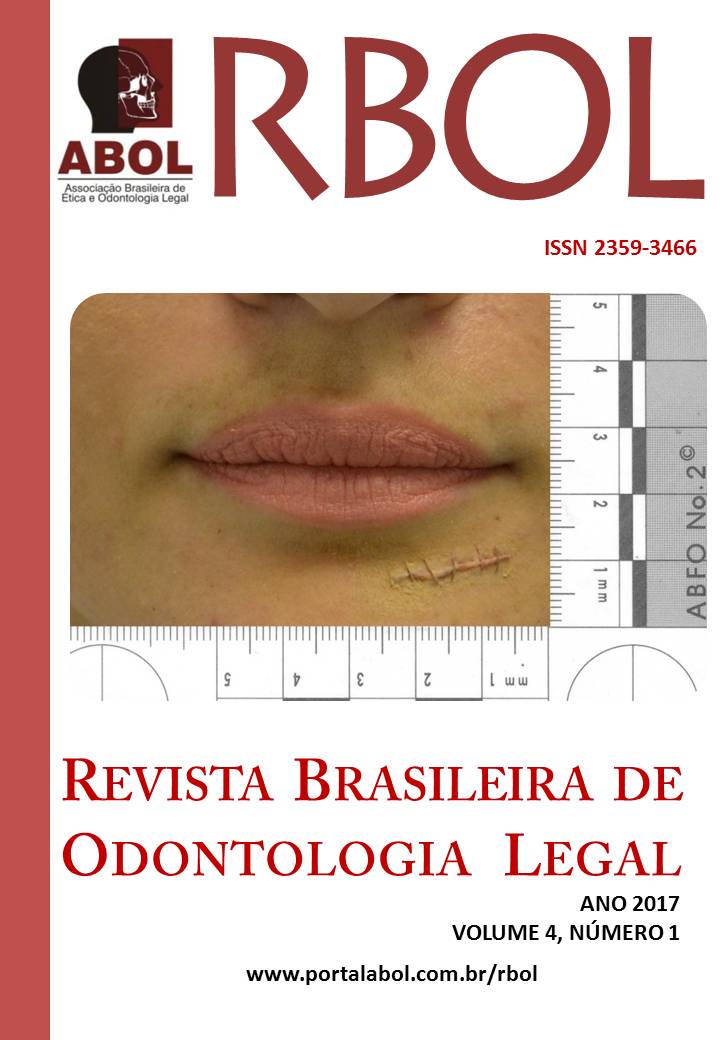ACCURACY OF ESTIMATING AGE FROM CERVICAL VERTEBRAL MATURATION AND MANDIBULAR MOLAR MATURATION
DOI:
https://doi.org/10.21117/rbol.v4i1.77Palavras-chave:
Cervical, vertebrae, dental, molar, age, accuracyResumo
Age estimation is required for forensic cases such as minors without documentation and age disputed by asylum seekers. Cervical vertebral maturation (CVM) has potential to estimate age as a new method of analysis of shape change during adolescence and adulthood. The aim of this study was to assess the accuracy of estimating age using Lamparski’s method of cervical vertebra maturation, the mandibular second (M2) and third molars (M3) in a group of males. The test sample consisted of lateral cephalograms of 60 boys from the Bolton-Brush online collection and 53 from Burlington online collection aged 10 to 15 years. CVM age was calculated from age category and mean age and transition age of CVM stages, calculated from raw data of 69 boys (aged 9 to 15 years) studied by Lamparski (1972). Dental age was calculated using mandibular second and third molar stages from Liversidge (2009). The mean difference and absolute mean difference between CVM age and dental ages and chronological ages was calculated. CVM and molar tooth stage assessment reliability was assessed by duplicate readings by the first author. Results show that Lamparski’s method of CVM mean age was most accurate and had considerably smaller standard deviation and smallest absolute mean difference than other method of M2 or M3 (mean difference -0.49, SD 0.23, absolute mean difference 0.49 years). CVM has potential as a possible method of estimating age for this age group, particularly when M2 is mature or M3 is missing.Referências
Lamparski D. Skeletal age assessment utilizing cervical vertebrae. Thesis, University of Pittsburgh, Pennsylvania. 1972.
Greulich WW, Pyle SI. Radiographic atlas of skeletal development of the hand and wrist. ed. 1959, Stanford: Stanford University Press.
Hellsing E. Cervical vertebral dimensions in 8-, 11-, and 15-year-old children. Acta Odontol Scand. 1991 Aug; 49(4): 207-13.
Israel H. Progressive enlargement of the vertebral body as part of the process of human skeletal ageing. Age Ageing. 1973 May; 2(2): 71-9.
Liguoro D. Vandermeersch B, Guérin J. Dimensions of cervical vertebral bodies according to age and sex. Surg Radiol Anat. 1994. 16(2): 149-55.
Heravi F, Imanimoghaddam M. Rahimi H. Correlation between cervical vertebral and dental maturity in Iranian subjects. J Calif Dent Assoc. 2011; 39(12): 891-6.
Demirjian A, Goldstein H, Tanner JM. A new system of dental age assessment. Hum Biol. 1973; 45(2): 211- 27.
Sachan K, Sharma V, Tandon P. A correlative study of dental age and skeletal maturation. Indian J Dent Res 2011; 22: 882. http://dx.doi.org/10.4103/0970-9290.94698.
Nolla C. The development of permanent teeth. J Dent Child, 1960. 27:254-66.
Fishman L. Chronological versus skeletal age, an evaluation of craniofacial growth. Angle Orthod. 1979 Jul; 49(3):181-9.
Mack KB, Phillips C, Jain N, Koroluk LD. Relationship between body mass index percentile and skeletal maturation and dental development in orthodontic patients. American Journal of Orthodontics and Dentofacial Orthopedics, 2013. 143(2): 228-34. http://dx.doi.org/10.1016/j.ajodo.2012.09.015.
Konigsberg LW. Multivariate cumulative probit for age estimation using ordinal categorical data. Ann Hum Biol, 2015. 42(4): 366-76. http://dx.doi.org/10.3109/03014460.2015.1045430.
Liversidge HM. Controversies in age estimation from developing teeth. Ann Hum Biol. 2015; 42(4): 395-404. http://dx.doi.org/10.3109/03014460.2015.1044468.
Moorrees CF, Fanning EA, Hunt EE Jr. Age variation of formation stages for ten permanent teeth J Dent Res, 1963. 42: 1490-502.
Cole TJ, Rousham EK, Hawley NL, Cameron N, Norris SA, Pettifor JM. Ethnic and sex differences in skeletal maturation among the Birth to Twenty cohort in South Africa. Arch Dis Child. 2015; 100: 138-43. http://dx.doi.org/10.1136/archdischild-2014-306399.
Cameriere R, Giuliodori A, Zampi M, Galić I, Cingolani M, Pagliara F et al. Age estimation in children and young adolescents for forensic purposes using fourth cervical vertebra (C4). Int J Leg Med. 2014: 1-9. http://dx.doi.org/10.1007/s00414-014-1112-z.
Benson J, Williams J. Age determination in refugee children. Aust Fam Physician. 2008 Oct; 37(10):821-5.
Ontell FK, Ivanovic M, Ablin DS, Barlow TW. Bone Age in Children of Diverse Ethnicity. AJR Am J Roentgenol. 1996 Dec; 167(6):1395-8.
Konigsberg LW, Herrmann NP, Wescott DJ, Kimmerle EH. Estimation and evidence in forensic anthropology: age-at-death. J Forensic Sci, 2008. 53(3): 541-57. http://dx.doi.org/10.2214/ajr.167.6.8956565.
Tokunaga AP, Franco A, Westphalen FH, Lima AAS, Fernandes A. Skeletal Age Estimation comparing two radiographic methods. Rev Bras Odontol Leg RBOL. 2015; 2(1):19-25. http://dx.doi.org/10.21117/rbol.v2i1.17.
Downloads
Publicado
Edição
Seção
Licença
Os autores deverão encaminhar por email, devidamente assinada pelos autores ou pelo autor responsável pelo trabalho, a declaração de responsabilidade e transferência de direitos autorais para a RBOL, conforme modelo abaixo.
DECLARAÇÃO DE RESPONSABILIDADE E TRANSFERÊNCIA DE DIREITOS AUTORAIS
Eu (Nós), listar os nomes completos dos autores, transfiro(rimos) todos os direitos autorais do artigo intitulado: colocar o título à Revista Brasileira de Odontologia Legal - RBOL.
Declaro(amos) que o trabalho mencionado é original, não é resultante de plágio, que não foi publicado e não está sendo considerado para publicação em outra revista, quer seja no formato impresso ou no eletrônico.
Declaro(amos) que o presente trabalho não apresenta conflitos de interesse pessoais, empresariais ou governamentais que poderiam comprometer a obtenção e divulgação dos resultados bem como a discussão e conclusão do estudo.
Declaro(amos) que o presente trabalho foi totalmente custeado por seus autores. Em caso de financiamento, identificar qual a empresa, governo ou agência financiadora.
Local, data, mês e ano.
Nome e assinatura do autor responsável (ou de todos os autores).

